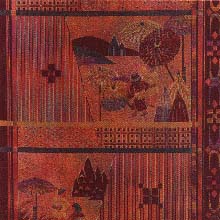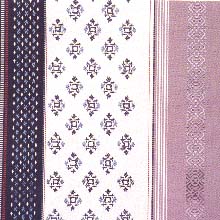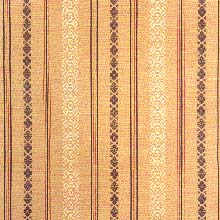Weave (p. 125 )
1. Produced in Fukuoka City, Fukuoka Prefecture.
2. Characteristics: Thick plain-woven silk fabric for sashes, hard to get loosened when put on. Having a unique rustling sound, it is lustrous and firm. Designs come out as the warp is raised after the weft is strongly woven in the compacted warp. There are 2 types: "Kenjo(present) Hakata Ori" and "Mon Ori(woven design) Hakata Ori." The Kenjo Hakata Ori is the fabric with continuous designs of stripes and stylized "Dokko" and "Hanazara." "Dokko" is an iron club, an instrument used in esoteric Buddhism. "Hanazara" is a plate on which incense is burned and also used in Buddhistic rites. The Mon Ori is a general name of the gorgeous fabric with multi-colored designs.
3. Uses: Sashes for men and women, "Date Jime"(under sash), neckties, handbags.
4. History: It is said that a man named Yazaemon Mizuta visited China in the company of monks and learned the technique, producing the fabric which is regarded as an origin of "Hakata Ori," in the Kamakura Period (1185-1333). It is natural, however, to presume that "Kara Ori(Chinese weave)" or "Kanton(Kuang Tung) Ori," which was transmitted by Chinese immigrants, was the origin because Hakata had been a big port since old days. The present Hakata Ori was invented by a master of braided cord, Iemon Takewaka, who improved the Kara Ori in the during1573-92. When Nagamasa Kuroda, a famous warrior, became the feudal lord in the 1600, he protected the production of the Hakata Ori and designated it as an item to be presented to the Shogunate. The name of "Kenjo Hakata Ori" came from that fact. In the "Kenjo Hakata Ori" only 5 colors were used imitating the system of Sui Dynasty in China: they are purple (which signifies virtue), red(decorum), yellow(sincerity), dark blue(wisdom) and blue(benevolence). A set of five sashes, each of which is woven in a single color (both for background and designs), was called "Goshiki(five colors) Kenjo." The feudal government kept the number of weavers at 12 in view of maintaining good quality and scarcity value. It was actually a control of production and made Hakata Ori very expensive. "Mon Ori Hakata" had been woven since the Edo Period (1600-1868) and developed much further after 1885 when the Jacquard weaving machine was imported. Most of the Hakata Ori were made for sashes for men but in the middle of the Meiji Period it gradually changed to become sashes for women.





